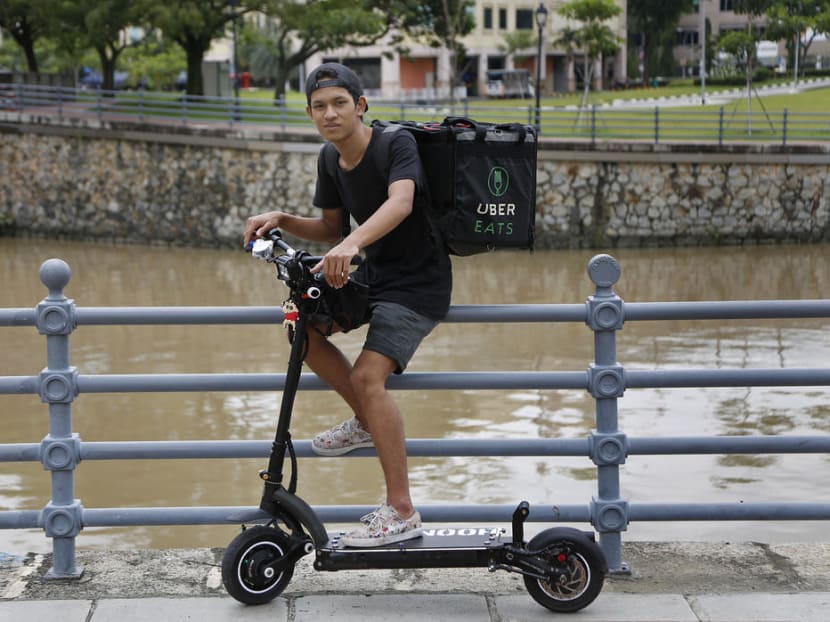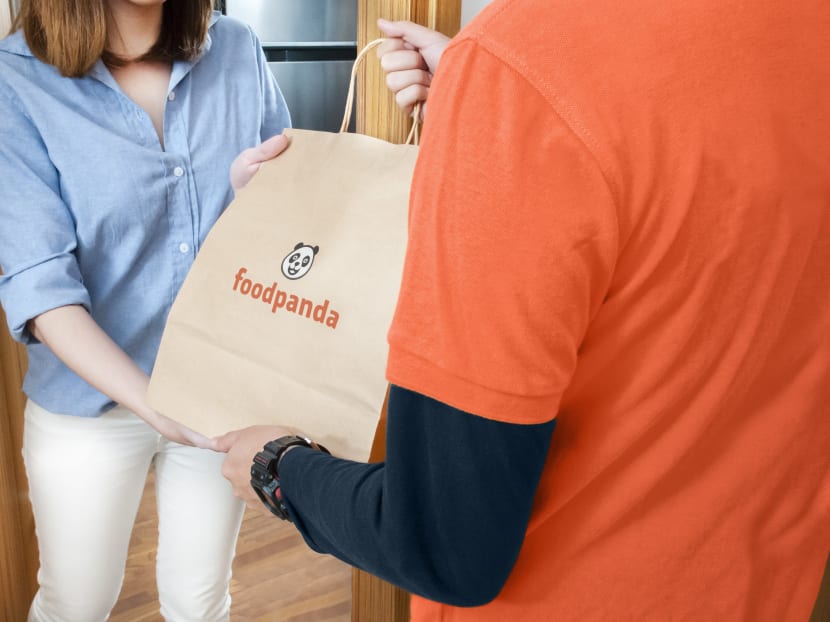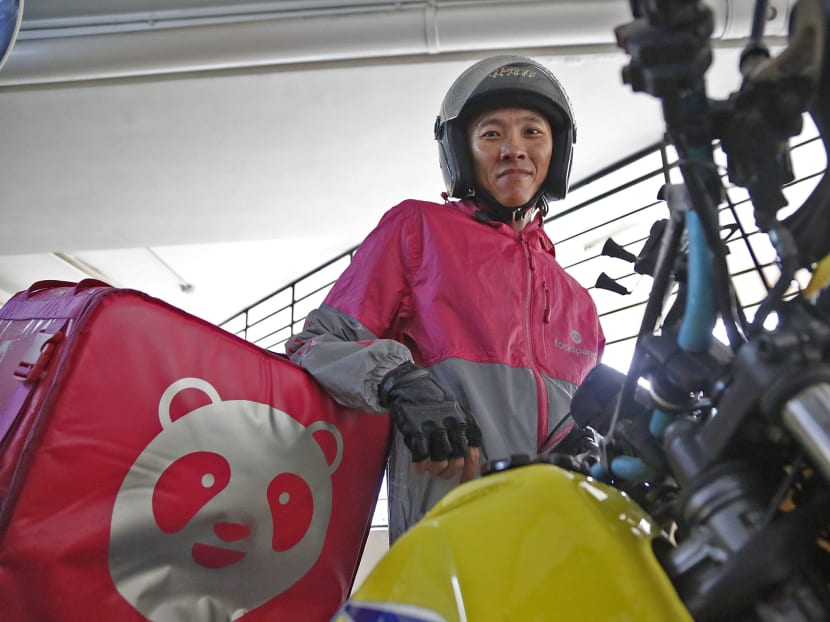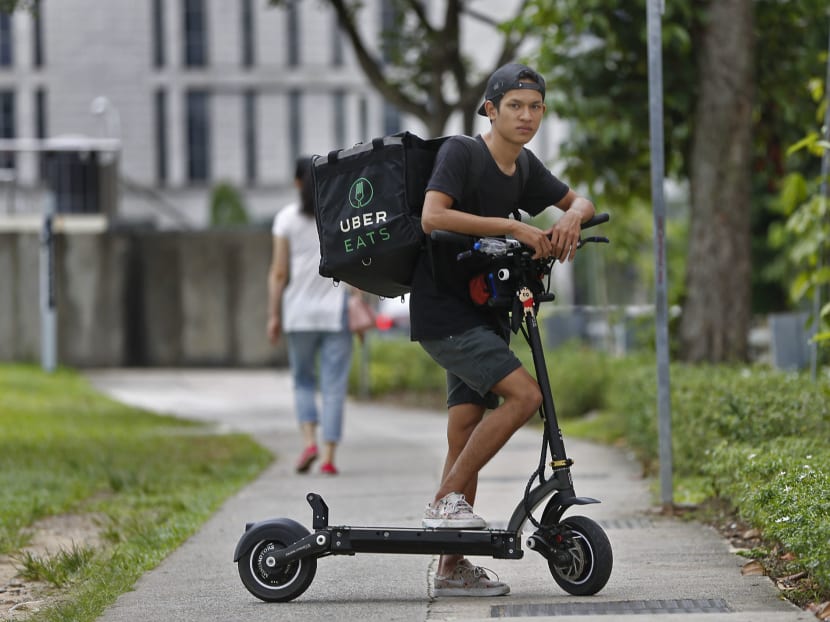The Big Read: When the world (of food) is at your fingertips
SINGAPORE — These days, Ms Lim Xiang Jun, 32, swears by food delivery services.

Muhammad Azrul, 18, uses a PMD to do food deliveries. He quit his job as a cleaner as he found delivering food easier while still making the same amount of money. Photo: Raj Nadarajan/TODAY
SINGAPORE — These days, Ms Lim Xiang Jun, 32, swears by food delivery services.
The project producer, who works from home, uses the services to order either lunch and dinner up to six times a week. Not only do the services help her become healthier — she makes it a point to order healthy food and jogs in the evenings while waiting for her meal to arrive — it has also enabled her to be more productive at work, as she does not waste time looking and queueing for food. “It is a godsend,” she said.
Like Ms Lim, many people are increasingly turning to food delivery services, with the industry enjoying an explosive growth worldwide including in Singapore.
Here, riders on motorbikes, bicycles and e-scooters decked out in bright uniforms are an ubiquitous sight, be it in the heartlands or in the Central Business District (CBD). For consumers, hardly a day goes when they do not make food orders on mobile apps. Restaurants and hawkers have also benefited from the knock-on effect, processing more orders each day.
Foodpanda, Deliveroo and UberEATS are the three biggest players in the Singapore market. Within the last few years, the volume of orders, number of eatery partners and the size of their delivery fleet have all increased exponentially, the three companies told TODAY.
Foodpanda Singapore managing director Luc Andreani said: “We don’t replace dine-ins and walk-ins… We are substitutes for groceries, for laziness. If you are lazy and you don’t want to cook or you’re not a great cook… then just order on Foodpanda and it should not cost you more than going to a restaurant.”

Local food delivery service foodpanda. Photo: foodpanda
THE BIG THREE
Among the major food delivery companies, Foodpanda was the first onto the scene in Singapore. The Berlin-based firm started operations here in 2012, when food delivery was largely provided by pizza and fast food restaurants.
Within five years, the company now has more than 1.5 million users and 3,500 restaurant partners here. It continues to acquire “thousands” of new customers each day, and receive “several tens of thousands” of orders daily, said the company declining to go into the specifics for commercial reasons. It has a pool of about 3,000 freelance delivery riders, up by 50 per cent since the beginning of last year.
Deliveroo, which is headquartered in London, was the next to arrive. Since its Singapore launch in 2015, it has seen on average, a 30 per cent month-on-month growth, the firm said. In the past year, its volume of orders has surged by 192 per cent. It has a network of about 4,000 delivery riders and some 3,000 restaurant partners so far.
Ride-hailing app Uber, which is based in San Francisco, rolled out its food delivery arm, UberEATS, in Singapore in 2016. Like Deliveroo, UberEATS started with food delivery in the CBD. It expanded the services islandwide in July last year. Today, it works with more than 2,500 restaurant partners, and “tens of thousands” of riders or delivery partners.
“The growth for the food delivery industry is a surprise, for it to emerge so quickly over the years,” said Dr Ang Swee Hoon, associate professor of marketing, National University of Singapore’s Business School. She attributed the industry’s rapid rise to changes in Singaporeans’ lifestyle needs, busier work schedules, and higher spending power.

An UberEATS food delivery scooter is seen parked in London. Photo: Reuters
FOR BETTER OR WORSE?
Some may say the proliferation of food delivery services could feed the sedentary and unhealthy Singaporean lifestyle, making it worse as people no longer have to get out of their couch to cook or look for food, with a staggering number of options at their fingertips.
But this may not always be the case. Take Ms Lim for example. Just a year ago, she used to order fast food and cook instant noodles to settle her meals. Now, she orders salads on her mobile apps, and goes for healthier options from restaurants such as Daily Cut, Haakon Superfood and Juice and Colin’s Grille Bento.
She also times her evening jogs with dinner. She orders her food first before going for a run, tracking the order on her mobile phone as she works up a sweat and timing her run to get home to receive the food.
Ms Lim, who lives in Clementi, said she spends about S$20 per order, which she felt was not expensive given that healthier food options from eateries typically cost about the same. Before using food delivery services, she had to take a bus to buy food. “I don’t mind paying extra for convenience rather than having no seats when I get to the eateries,” she said, adding that the food delivery usually comes on time barring a handful of occasions when it was late for about 10 minutes.
.embed-container { position: relative; padding-bottom: 56.25%; height: 0; overflow: hidden; max-width: 100%; } .embed-container iframe, .embed-container object, .embed-container embed { position: absolute; top: 0; left: 0; width: 100%; height: 100%; }For Ms Angie Ng, 50, using food delivery services also helps her save time. The contracts manager orders food for her husband and herself five times a week, spending between S$18 and S$30 each time. Previously, she would spend time driving to coffee shops for her meals after finishing work. She noted that food delivery services help the couple save on service charge at restaurants as well, which can be hefty when they eat out.
Mr Charlie Ang, 46, is another regular user who is enjoying the convenience. “It’s so much more convenient now without me having to get changed, drive out and worry about parking,” said the director for strategic partnerships at NTUC Link, who orders zi char (cooked food) for the family during the weekends once a month.
According to the major food delivery companies, the top food items ordered by Singapore customers last year include burrito bowl, bubble tea and nasi ayam penyet.
Based on its data, UberEATS said that its customers in Jurong tend to order American food while those in Queenstown favoured Mexican cuisine. Residents in Hougang, Serangoon and Punggol preferred Chinese food and those in Changi craved for Middle Eastern dishes.
Not everyone is fully sold, however. There are those who prefer to cook and would rather eat the food fresh and piping hot at the eateries.
For example, Ms Tram Hien, 27, who works in the Land Transport Authority as an assistant manager, said she likes to cook and the food delivery services are an option when hunger pangs strike.
Business development manager Bobby Tan, 35, said he avoids using the services for raw seafood such as sashimi or sushi which “might not be as fresh as it takes a while to deliver”. Nevertheless, he turns to the food delivery services about once every fortnight, especially when he hosts gatherings among family and friends.
Related articles
- The perks and perils of being a food delivery rider
- Food delivery companies vying for a slice of the pie
‘ANYONE WILLING TO WORK CAN EARN MONEY’
It is not just consumers who have benefited from the rise of the industry, which has also created a huge demand for delivery riders.
UberEATS general manager (Singapore and Malaysia) Shri Chakravarthy Gopalakrishna believes this has given a leg-up to people who may otherwise struggle financially.
He said: “Anybody who is willing to work and deliver, has the opportunity to earn (money as a delivery rider).”
For instance, UberEATS hires freelance riders who are senior citizens as well as those with physical disabilities.
Between the three major food delivery companies, they have tens of thousands of riders on their books. The riders are allowed to work for more than one company. Most riders interviewed by TODAY said the job was a temporary fix to tide them over, as they look for other job opportunities.

Father of two, Edgar Soon, 43, took up the job as a food delivery rider after losing his job as a lab technician in a shool. He now earns about double of what he used to earn, working 5-6 days a week, delivering about 25 orders a day. Photo: Raj Nadarajan/TODAY
Foodpanda delivery rider Edgar Soon, 43, took on the job over a year ago when he lost his previous job as a laboratory technician.
He said he earns about S$3,000 to S$4,000 a month as a delivery rider, double his previous income. The job also gives him the flexibility to spend more time with his family or run errands. Sometimes, however, he has to wolf down his meals when there is a rush of orders. “I try to grab a bite between orders, as we usually expect orders throughout the hours that we are working,” said Mr Soon, adding that he does not intend to stay in this line for long.
Mr Muhammad Azrul, 18, is working as a delivery rider for UberEATS while waiting for enlistment into National Service.
Mr Azrul, who lives in Queenstown, has been delivering food on his personal mobility device (PMD) for about seven months in the Central Business District. “I got referred to the job by my uncle,” he said.
He earns around S$1,200 a month, delivering seven to 12 orders a day and works 5 days a week, during lunch and dinner hours. Previously, he worked as a cleaner, taking home S$1,300 a month. Before he became a full-time delivery rider, he delivered food after work ended at 5pm to earn extra income.

Muhammad Azrul, 18, uses a PMD to do food deliveries. He quit his job as a cleaner as he found delivering food easier while still making the same amount of money. Photo: Raj Nadarajan/TODAY
“As I was tired after my morning job, the PMD was the best option as it is easier to move around,” he said.
Now, work is “own time own target” and there are no bosses “to scold me,” said Mr Azrul, who holds an N-level certificate. He added that he has made many friends through his current job, including fellow PMD delivery riders.
He said the customer feedback and ratings encourage him to do better. There have been occasions where he got tips from customers, he said. But he added: “The pay is not consistent. We are paid according to trips we do. During holidays seasons, there are fewer trips and hence less pay.”
Student Muhammad Syawal, 18, who works part-time with Foodpanda, said he earned about S$1,000 to S$2,000 a month, working 4 to 5 days a week. “As a student, I feel that Foodpanda and its flexible timing makes it easier for me to manage my time,” he said.
Deliveroo rider Muhammad Fitri Mohd Ismail, 23, is among those who see it as a permanent job. He has been working with the firm for about two years, and plans to continue for the “next few years”.
Mr Fitri said he can earn up to S$4,500 to S$5,500 a month, depending on how frequently he works. “I have always been in the dispatching business so if there wasn’t Deliveroo I would still be involved in the delivery industry,” he said.
He added: “I like being on the road rather than being stuck in an office. Working as a rider also allows me the freedom and flexibility to work when I want to. I’m my own boss.”
THE SPIN-OFFS
Anecdotally, the growth of the industry has also indirectly created more jobs in the food and beverage sector to cope with the rising demand.
Deliveroo general manager (Singapore) Siddharth Shanker said 590 jobs were created within the restaurant industry here after the firm started operating in Singapore, based on a report which the company commissioned to assess its economic impact on the various markets it operates in. Published last year, the report was conducted by economics research company Capital Economics.
From hawker stalls to well-known restaurants and fast food chain McDonald’s, eateries are increasingly partnering food delivery companies.
McDonald’s, which has its own delivery service McDelivery, recently joined hands with UberEATS. Including Singapore, there are a total of 14 countries where UberEATS and McDonald’s have linked up.
At a press conference in October last year announcing the partnership, McDonald’s Singapore managing director Kenneth Chan noted a shortage of riders during peak periods.
Under the tie-up, McDelivery will continue to deliver 24/7 islandwide with a S$4 flat fee, while UberEATS will deliver for McDonald’s between 8am and 11pm every day and will charge a S$3 delivery fee, plus additional “surge” prices during peak periods.
Fried chicken chain 4Fingers, which has partnered Deliveroo and Foodpanda, has seen its delivery business grown sharply in almost two years since its delivery business arm was launched.
“Out of our 12 outlets in Singapore, the delivery revenue for the six outlets that offer home delivery can be as high as 30 per cent. We see a clear demand from our consumers who enjoy the convenience,” said 4Fingers chief executive Steen Puggaard.
However, Mr Puggaard felt the commission fees that restaurants pay to delivery companies — which can be as high as 30 per cent — should be reduced. He pointed out that restaurant operators find it difficult to profit from home deliveries when they add up their raw material, labour, and rental costs together with the commission fees.
Crystal Jade, which had started working since early 2016 with Foodpanda and Deliveroo, said the growth in its delivery segment since the collaborations “has been very encouraging”.
“We are expecting more growth… the various campaigns have brought us good recall and awareness. These can be seen from sales and returns,” said Ms Cynthia Yee, senior vice president for marcom at Crystal Jade Culinary Concepts.
Ms Yee agreed that the commission charged by the delivery companies are “on the high side”. However, she said her company “understands the high operating cost our partners have to manage”.
Apart from established eateries, food delivery has also helped smaller players including stalls at coffee shops and hawker centres, grow their business.
About a year ago, Mr Steve Yong, 42, a shareholder of the Hua Zai hawker stalls, decided to work with the food delivery companies to reach out to more customers.
There are currently more than 30 Hua Zai hawker stalls islandwide, selling roasted duck and zi char dishes. Since it started partnering the food delivery firms, it saw a 10 to 20 per cent increase in the number of takeaway orders.
But Mr Yong also felt the commission fees are steep, and these eat into the profits. Still, the benefits outweigh the costs. “Nowadays, many people buy things online and the stalls can only attract customers staying nearby,” he said.
Ms Jenny Law, 53, said she reached out to the food delivery companies on her own about a year ago. She owns three stalls — selling zi char, Western food and fishball noodles — at two coffeeshops in Ubi and Bedok.
“I order from food delivery (companies) all these while, that’s why to me, it’s quite natural for me to join this,” she said. She added that her stalls do not see high walk-in traffic and the delivery platforms help her reach out to more customers. Going forward, she hopes to open another Western food stall that only sells food for deliveries.

TODAY file photo
THE NEXT BIG THING
Delivery-only spaces appear to be the next big thing, in the rapid evolution of the food delivery business.
In April last year, Deliveroo introduced a delivery-only kitchen in Katong. Known as Deliveroo Editions, the 2,110 sq ft area does not have dine-in space but provides selected restaurants and eateries with the equipment and storage space to prepare food.
New Ubin Seafood for instance, offers three “concepts” via the Deliveroo Editions, offering signature items, different grilled meats and locally-flavoured rice bowls. Its owner Pang Seng Meng said the response has been positive, and it could reach out to new customers via under the different concepts.
“It was an opportunity for us to have the same partnership where we focus on the food, and Deliveroo focuses on customers and riders,” he added.
Deliveroo said it intends to open two more delivery-only kitchens by this year while Foodpanda has similar plans to roll out a “satellite kitchen” by the end of this month.
4Fingers is also looking to establish a delivery-dedicated outlet in Clementi, as reported by TODAY previously. The company wants to handle some deliveries in-house to mitigate the profit leakage from selling through the food delivery companies.
It is still on the lookout for the ideal location. Meanwhile, Mr Puggaard said the company has been beta-testing a delivery service where customers can order directly from its website.
To meet the needs of customers like Ms Lim, Deliveroo has also partnered the Health Promotion Board to identify healthier options on its menu. Five of the eight most-ordered dishes on Deliveroo comes under its app’s “Healthy Food” section.
Dr Ang said the industry still has some room to grow — which can only be good news to consumers as they enjoy greater options, and innovation by the companies.
“The delivery industry is flourishing,” she said. “Now the market is growing there is no need for any consolidation yet. The pie is still big for the players.”






